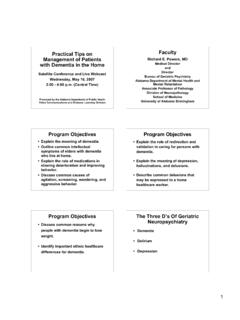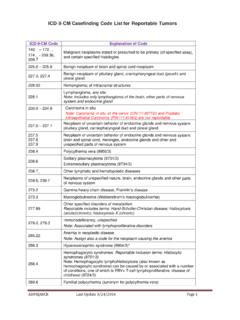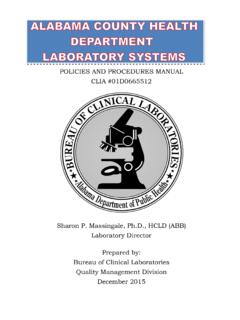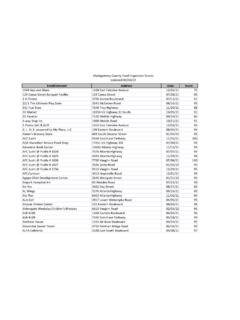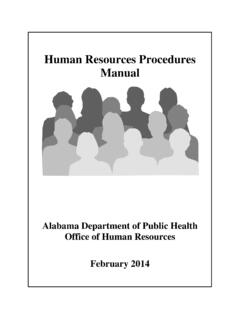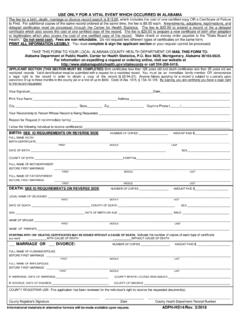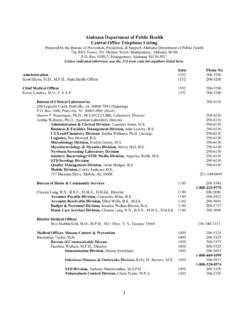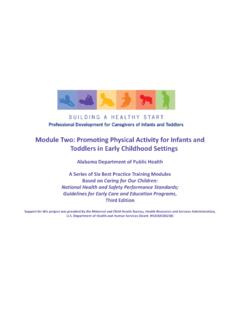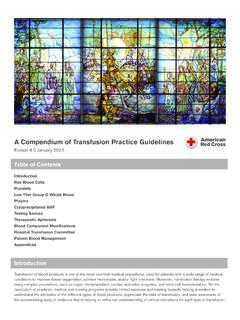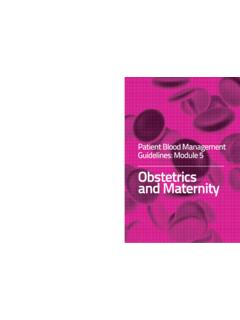Transcription of Newborn Screening Blood Collection Guidelines
1 Newborn Screening REFERENCE MANUAL FOR PROVIDERS19 Newborn Screening Collection GUIDELINESA labama Department of Public Health Bureau of clinical Laboratories Newborn Screening Division 8140 AUM Drive, Zip 36117-7001, Box 244018, Zip 36124-4018, Montgomery, AL Phone: 334-260-3476 FAX: 334-260-3439 Sharon P. Massingale , PhD, HCLD/CC(ABB), Public Health Laboratory Director Aretha M. Williams, PhD, Laboratory Assistant Director Danita M. Rollin, BS, MT (ASCP), Newborn Screening Laboratory Division ManagerContacts: Deannie Morris, Lynn Green and Derek KennedyALABAMA DEPARTMENT OF PUBLIC HEALTH BUREAU OF clinical LABORATORIESN ewborn Screening Collection Guidelines Revised 4/1/2019 Newborn Screening REFERENCE MANUAL FOR PROVIDERS20 Newborn Screening Collection GUIDELINESS ection 22-20-3 (as amended in 1987)
2 Of the Code of Alabama states that all infants must be administered a reliable test for PKU, Cystic Fibrosis, Hypothyroidism, CAH, Galactosemia, Abnormal Hemoglobins, Biotinidase Deficiency, Severe Combined Immunodeficiency, Amino Acid Disorders, Fatty Acid Disorders, and Organic Acid Disorders and that the testing be performed by the Public Health OF Screening :FIRST TEST ( A FORM) This specimen is tested for Hypothyroidism, CAH, Cystic Fibrosis, Galactosemia, Severe Combined Immunodeficiency, Hemoglobinopathies, Biotinidase Deficiency, Amino Acid Disorders, Fatty Acid Disorders, and Organic Acid Term Infants A Newborn Screening test should be collected when the infant is 24-48 hours of age.
3 If the infant is discharged prior to 24 hours of age, a specimen MUST be obtained before discharge, and the parent or guardian must be informed of the importance of obtaining a repeat test before one week of BirthsThe Newborn Screening Statute applies to all infants born in Alabama. The birthing attendant is responsible for collecting the Newborn Screening test. It is recommended that the test be collected at 24-48 hours of Hospital Stay (low birth weight/sick infants)It is recommended that a specimen be collected upon admission to the NICU if the infant is expected to receive TPN or transfusions unless the infant is so unstable that it cannot be done safely.
4 Refer to the Alabama Newborn Screening Sick Infant Blood Collection Guidelines on page InfantsInfants admitted to NICU for short term observation but who are not receiving TPN or transfusions should have a specimen collected according to the Full Term Infant InfantsIf an infant is likely to die, it is appropriate to collect a Newborn Screening specimen. While dying infants may have abnormal results as a response to organ failure, the specimen may also provide a diagnosis of an early onset Screening InfantsThe American Academy of Pediatrics recommends that physicians know the Screening status of all children in their care.
5 While older infants may enter the practice without evidence of a Newborn screen, the Alabama Department of Public Health s Newborn Screening Program has established standards and cutoffs for newborns and infants and therefore cannot accept specimens on children older than 12 months of CONSIDERATIONS:TransfusedInfantsA specimen should be collected prior to transfusion regardless of age or treatments unless the infant is so unstable it cannot be done safely. If the specimen is not collected prior to transfusion , collect a specimen greater than 72 hours post transfusion . Another specimen should be collected at 3-4 months post transfusion for Hemoglobinopathies, Biotinidase Deficiency, and Galactosemia.
6 If a Galactosemia condition is suspected and the specimen was not collected prior to transfusion , place the infant on a galactose-free diet until a definitive diagnosis can be InfantsThe transferring facility must collect a specimen prior to transfer regardless of age or treatments unless the baby is so unstable that it cannot be done safely. If the specimen cannot be obtained prior to transfer, the transferring facility must ensure that the next facility is aware of the need for Collection of the Newborn Screening RefusalParents may refuse Newborn Screening only for religious reasons.
7 Parents who refuse under this condition should sign a statement that is placed in the infant s medical record. A Newborn Screening Collection form should be filled out completely with a statement as to the refusal and mailed to the State Screening REFERENCE MANUAL FOR PROVIDERS21 Newborn Screening Collection GUIDELINESSECOND TEST ( B FORM) This specimen is tested for Hypothyroidism, CAH, Cystic Fibrosis, Galactosemia, Biotinidase Deficiency, Amino Acid Disorders, Fatty Acid Disorders, and Organic Acid : This specimen is not routinely tested for Hemoglobinopathies. If no valid test has been done for this disorder, please see instructions below for Collection of requested repeat specimens, Requested Repeat.
8 1. A second Newborn Screening specimen should be collected at 2-6 weeks of age (4 weeks optimal) on all full term infants with a normal first test If the first test specimen was collected when the infant was greater than one week of age but less than two weeks of age, the second test specimen should be collected at 4-6 weeks of If the first test specimen was collected after two weeks of age, a second ( B ) specimen need NOT be Repeat ( B form)1. A repeat specimen may be requested by the State Laboratory when the results are abnormal or questionable. The specimen should be collected in the time frame indicated by the report.
9 The Retest-Prior Abnormal box must be marked on the Collection If the first test is unsatisfactory for testing, a repeat test should be collected as soon as possible. The Retest-Prior Unsat box must be marked on the Collection OF FILTER PAPER BLOODSPOT SPECIMENM aterials needed for Blood Collection :1. Gloves2. 70% isopropyl alcohol pads3. Dry sterile gauze pads4. Sterile sticking device with a point not greater than mm in depth (the most effective method is the use of scalpel bladed lancets)5. Newborn Screening filter paper Collection form (CL-89) with protective envelopeBleeding Procedure:1.
10 The preferred puncture site is indicated by the shaded areas on the heel. The least hazardous sites for heel puncture are medial to a line drawn posterior from the middle of the big toe to the heel or lateral to a similar line drawn on the other side extending from between the 4th and 5th toe to the Warm the infant s foot if necessary using warm water, a towel, or a chemical pack. Heat sources should not exceed 42 C and should not be left in contact with the skin for a prolonged Disinfect the skin with alcohol pads and allow to air dry. Vigorous rubbing during this step stimulates Blood flow to the Puncture the skin in one continuous motion using a sterile sticking device with a tip < mm.
